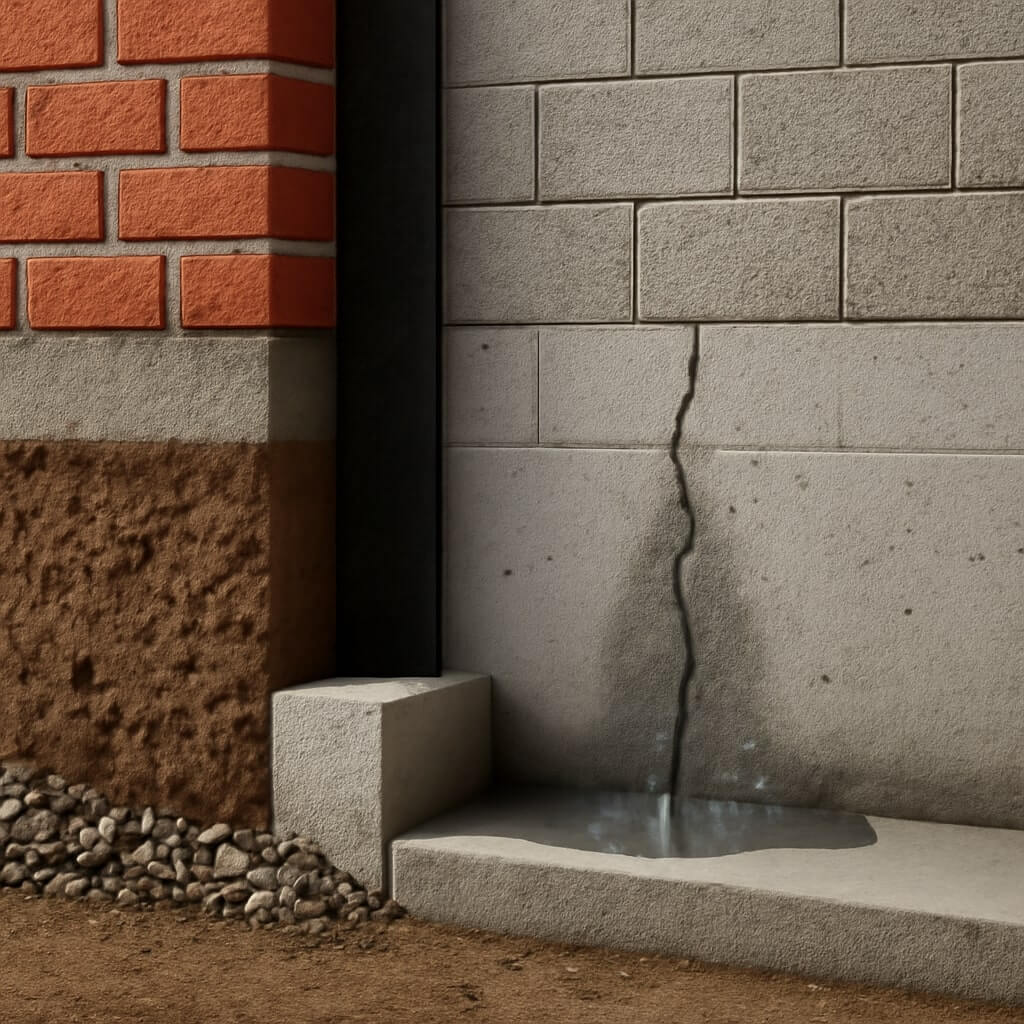When it comes to basement waterproofing, several key factors can greatly impact your costs. Your home’s location, the type of waterproofing system you choose, and the severity of any existing water damage all play vital roles. Additionally, the size of your basement and its accessibility can further complicate expenses. Understanding these elements is important for effective budgeting. So, what should you prioritize to guarantee you make the best decision?
Key Takeaways
- The location’s climate significantly influences waterproofing costs due to varying rainfall and humidity levels.
- The type of waterproofing system selected, such as interior or exterior options, affects overall expenses and effectiveness.
- The severity of existing water damage determines the extent of repairs needed, impacting total waterproofing costs.
- The size and shape of the basement directly correlate with material and labor expenses for waterproofing projects.
- Accessibility challenges, including soil type and proximity to utilities, can complicate the installation process and increase costs.
Location of Your Home
When considering basement waterproofing prices, the location of your home plays a crucial role.
Your area’s climate impact can greatly affect both the severity of water issues and your waterproofing costs. For instance, homes in regions with heavy rainfall or high humidity may require more robust solutions, increasing expenses.
Additionally, regional regulations can dictate specific waterproofing methods and materials, which can vary in price. Understanding these local factors helps you budget accurately and choose the right approach.
Ultimately, knowing how your location influences waterproofing needs empowers you to make informed decisions for your home’s protection.
Type of Waterproofing System
The type of waterproofing system you choose can greatly impact your overall costs and effectiveness in keeping your basement dry.
Interior drainage systems, like sump pumps and French drains, effectively manage water buildup inside your home, but they may require regular maintenance.
On the other hand, exterior barriers, such as membrane coatings and drainage boards, prevent water from reaching your foundation, offering a more proactive approach.
Each option has its advantages, so consider factors like your budget and the specific moisture issues in your area.
Making the right choice can save you money and stress in the long run.
Severity of Water Damage
Although you might think all water damage is the same, the severity can vary considerably and directly affects your waterproofing needs.
A thorough water damage evaluation is essential to determine the extent of the issues you’re facing. Minor leaks might only require simple repair methods, while severe flooding could necessitate extensive renovations.
Understanding the severity helps you choose the right waterproofing solutions and budget accordingly. If you ignore the signs, you risk escalating problems that can lead to higher costs down the line.
Prioritize evaluating the damage to guarantee you select effective repair methods tailored to your specific situation.
Size of the Basement
When considering basement waterproofing, the size of your basement plays an essential role in the overall cost.
Larger square footage typically means more materials and labor, which can increase expenses.
Additionally, if your basement has high ceilings, that may also impact the complexity and price of the waterproofing project.
Basement Square Footage
Understanding your basement’s square footage is essential for accurate waterproofing estimates. The size of your basement directly impacts the cost and type of waterproofing materials you’ll need.
Here are three key considerations regarding basement dimensions:
- Total Area: Larger basements require more materials and labor, increasing costs.
- Shape: Irregularly shaped basements may complicate the waterproofing process, adding to expenses.
- Access: If your basement’s layout makes access difficult, it can lead to higher labor costs.
Take these factors into account to guarantee you’re prepared for the investment in effective basement waterproofing.
Ceiling Height Considerations
Ceiling height plays an essential role in your basement waterproofing project, as it can influence both the cost and the methods used. Height regulations may dictate your ceiling design, impacting how waterproofing solutions are applied. A higher ceiling often allows for more effective drainage systems, while lower ceilings may complicate installation and increase costs.
| Ceiling Height | Cost Impact | Installation Method |
|---|---|---|
| Under 7 ft | Higher costs | Limited options |
| 7-8 ft | Moderate costs | Standard methods |
| Over 8 ft | Lower costs | Advanced solutions |
Consider these factors to make informed decisions!
Accessibility of the Area
When considering basement waterproofing, the accessibility of the area plays an essential role in determining costs.
If the site has location challenges or tight spaces, maneuvering equipment can become complicated and time-consuming.
Additionally, the presence of underground utilities can further impact both the approach and the overall price of the project.
Site Location Challenges
While tackling basement waterproofing, you might encounter site location challenges that particularly affect accessibility.
These challenges can lead to increased costs and complications, especially regarding drainage issues and soil composition.
Here are three key factors to take into account:
- Proximity to Water Sources: Nearby rivers or lakes can complicate drainage solutions.
- Soil Composition: Clay-heavy soils retain water, making waterproofing more complex.
- Terrain Features: Steep slopes or rocky landscapes may hinder access for equipment and materials.
Equipment Maneuverability
Although you mightn’t think about it at first, equipment maneuverability plays an essential role in the success of your basement waterproofing project. The types of equipment used, such as pumps and excavators, can greatly impact efficiency.
If the workspace is cramped or has tight corners, maneuverability challenges arise, making it tough for crews to operate effectively. This can lead to increased labor costs and longer project timelines.
Ensuring your basement area is accessible for various equipment types will help minimize these challenges, ultimately contributing to a smoother process and potentially lowering your overall waterproofing expenses.
Underground Utilities Presence
Maneuvering equipment becomes even more complicated when underground utilities are present.
You have to take into account several factors to guarantee a safe and efficient waterproofing job:
- Utility Mapping: Before starting, it’s essential to identify the location of all underground utilities to avoid costly damages or delays.
- Excavation Techniques: Using proper techniques can minimize disruption and risk to existing utilities.
- Access Limitations: Tight spaces may restrict equipment movement, impacting both time and cost.
Being aware of these factors can help you navigate the challenges and keep your basement waterproofing project on track.
Material Costs
When it comes to basement waterproofing, understanding material costs is essential for budgeting your project effectively. The quality of materials you choose directly impacts both durability and performance. Higher-quality materials might come at a premium, but they often save you money in the long run by reducing future repairs. Additionally, the installation techniques you opt for can influence overall costs. Here’s a quick comparison of common materials:
| Material Type | Estimated Cost per Square Foot | Durability Rating |
|---|---|---|
| Asphalt Membrane | $2 – $4 | Moderate |
| Liquid Rubber | $3 – $6 | High |
| Drainage Board | $1 – $3 | Low |
Labor Expenses
Understanding labor expenses is essential for accurately estimating your basement waterproofing project’s total cost.
Labor rates can vary considerably based on experience and location. Additionally, the project duration impacts overall expenses. Here’s what to reflect on:
- Labor Rates: Skilled workers may charge higher rates, but they often complete tasks more efficiently.
- Project Duration: Longer jobs can increase costs due to extended labor time and potential delays.
- Complexity: More complicated projects require specialized labor, which can drive up rates.
Conclusion
In summary, when planning your basement waterproofing project, keep these seven factors in mind. Your home’s location, the waterproofing system you choose, the extent of water damage, the basement’s size, and accessibility all play vital roles in determining costs. By understanding material and labor expenses, you can better budget for your project. Taking the time to evaluate each aspect will help guarantee you make informed decisions and ultimately protect your home from water damage.

